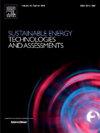Sustainable approach to cigarette butts management: From waste to new building material component
IF 7.1
2区 工程技术
Q1 ENERGY & FUELS
Sustainable Energy Technologies and Assessments
Pub Date : 2024-10-30
DOI:10.1016/j.seta.2024.104039
引用次数: 0
Abstract
The global waste crisis is exacerbated by the massive daily consumption and disposal of millions of cigarettes. An effective solution to address this issue involves repurposing cigarette butts (CBs), offering a promising avenue for waste management. This research focuses on transforming CBs into environmentally sustainable building materials. A comprehensive analysis of the most common types of CBs was conducted to assess their different thermal and acoustic properties. Subsequently, these CBs were integrated at 2.5 wt% in both a gypsum and cement mixture to produce panels for building applications. In addition, the feasibility of introducing a significantly higher concentration of CBs into these mixtures to produce mineralized samples was explored, achieving a CBs: gypsum/cement: water ratio of 1:2:3. All the panels analyzed showed superior thermal and acoustic characteristics compared to traditional ones, demonstrating the potential of this innovative approach. The introduction of CBs enhanced panel thermal properties and acoustic absorption coefficients. Incorporating recycled CBs in building material production promotes the creation of efficient, sustainable products while extending the lifespan of discarded waste. Life Cycle Assessment of a gypsum panel with CBs analyzed emissions, significantly contributing to waste management by reducing emissions and minimizing harmful substance release into the environment.
烟蒂管理的可持续方法:从废弃物到新型建筑材料
每天数以百万计的香烟被大量消耗和丢弃,加剧了全球废物危机。解决这一问题的有效办法是将烟头(CBs)再利用,这为废物管理提供了一条前景广阔的途径。这项研究的重点是将烟头转化为环境可持续建筑材料。研究人员对最常见类型的烟头进行了全面分析,以评估其不同的热学和声学特性。随后,在石膏和水泥混合物中以 2.5 wt% 的比例混合这些 CB,以生产建筑用板材。此外,还探讨了在这些混合物中引入更高浓度的 CBs 以生产矿化样品的可行性,使 CBs:石膏/水泥:水的比例达到 1:2:3。与传统板材相比,所有被分析的板材都显示出更优越的热学和声学特性,证明了这种创新方法的潜力。CBs 的引入增强了板材的热性能和吸声系数。在建筑材料生产中采用回收的 CB 可促进创造高效、可持续的产品,同时延长废弃物的使用寿命。使用 CBs 的石膏板的生命周期评估分析了排放情况,通过减少排放和最大限度地减少向环境中释放有害物质,极大地促进了废物管理。
本文章由计算机程序翻译,如有差异,请以英文原文为准。
求助全文
约1分钟内获得全文
求助全文
来源期刊

Sustainable Energy Technologies and Assessments
Energy-Renewable Energy, Sustainability and the Environment
CiteScore
12.70
自引率
12.50%
发文量
1091
期刊介绍:
Encouraging a transition to a sustainable energy future is imperative for our world. Technologies that enable this shift in various sectors like transportation, heating, and power systems are of utmost importance. Sustainable Energy Technologies and Assessments welcomes papers focusing on a range of aspects and levels of technological advancements in energy generation and utilization. The aim is to reduce the negative environmental impact associated with energy production and consumption, spanning from laboratory experiments to real-world applications in the commercial sector.
 求助内容:
求助内容: 应助结果提醒方式:
应助结果提醒方式:


